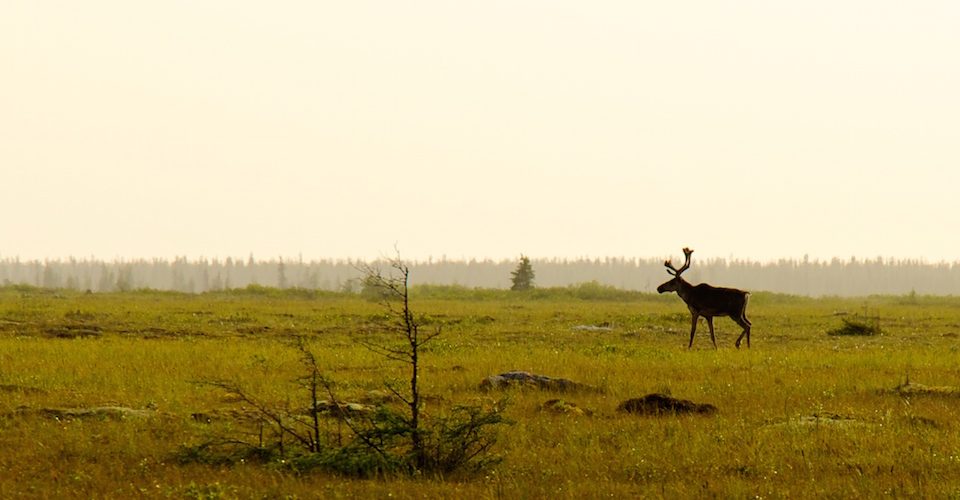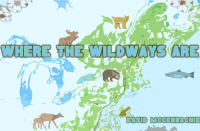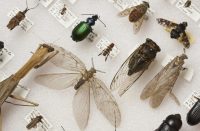Habitat. It is what species need to survive; there are no two ways about it. Yet, as forests continue to be felled, wetlands drained, rivers dammed and grasslands ploughed under, wildlife habitat is disappearing.
Habitat. It is what species need to survive; there are no two ways about it. Yet, as forests continue to be felled, wetlands drained, rivers dammed and grasslands ploughed under, wildlife habitat is disappearing.
The two of us have been working to protect habitat and the wildlife that depends on it for more than twenty years. We currently work for leading Canadian environmental organizations, championing at-risk species ranging from monarchs to snapping turtles to caribou. This has involved negotiating with industry, advising government, mobilizing our members, writing reports, hosting workshops, collecting signatures…you get the picture. Meanwhile, half of the planet’s wildlife has disappeared in our lifetime.
Here in Canada, it is becoming increasingly apparent that the primary value placed upon our lands and waters is economic.
Take the habitat of boreal woodland caribou for example, a species threatened with extinction.
For some species, habitat needs are not well known, a situation that can often lead to a stalling tactic.
For some species, habitat needs are not well known, a situation that can often lead to a stalling tactic – what environmentalists have dubbed “talk and log” – interested parties arguing about the science while business continues as usual. Yet, for these caribou, which dwell in the boreal forest across most of Canada, basic habitat needs are known. There can be no pretence that decision makers lack the relevant science in this case.
In 2012, the federal government released its boreal woodland caribou recovery strategy which, significantly, outlines a clear relationship between habitat disturbance (from fires, logging roads, clearcuts, seismic lines etc.) and caribou calf survival. Based on the science compiled by Canada’s leading caribou experts, the federal government set targets that a minimum of 65 per cent of each caribou range across the country be maintained or restored to an undisturbed condition, to afford an approximately 60 per cent probability that caribou will persist. Not great odds, but at least tipping in the right direction. The federal government left the door open for provinces and territories to take a more precautionary approach should they be more comfortable with a less risky probability.
This baseline for habitat protection was also incorporated into the Recovery Strategy for Southern Mountain Woodland caribou, released in 2014. Southern Mountain caribou are also threatened with extinction. These recovery strategies equip provinces and territories with the information needed to manage landscapes for increased odds of caribou survival, as opposed to relying on guessing games about appropriate management measures. It could have been a game-changer.
But instead of changing their game, most provinces continue to allow industry to fragment and destroy areas known to be needed for caribou survival. For example, Ontario continues to approve logging in intact caribou habitat along the southern edge of the caribou’s current range. In Alberta, the province most hammered by industrial disturbance, the government continues to sell leases to the oil and gas industry in some of the last few parcels of habitat that are not already leased.
In June 2014, the Alberta Energy Minister responded to criticisms with the following:
[The sale] doesn’t grant industry unrestricted access to the land – they have to operate within the restrictions and they know that going in. They still have a regulatory process to go through…We’re looking at the learnings with regards to how do we work together with the different industries in those areas to minimize those footprints…If you look anywhere around the world, Alberta has strict regulations with regard to oil and gas development.
Somewhere in the process either the application or the content of these “strict regulations” got lost in translation. The Alberta Fish and Game Association, a hunting and angling organization not often on-side with environmentalists, called the government’s lease sales “reckless.”
Collectively, we are losing our sense of what the recovery of an at-risk species really means.
Rather than working to maintain existing habitat that supports imperilled caribou populations, many within industry and government are doing backflips to do everything but protect habitat: killing wolves that prey upon caribou while habitat destruction continues, killing other ungulates with which caribou share the land (because they attract wolves) and building fences around pregnant females during calving season. The conversation has moved so far from where it should be that industry has estimated the costs of constructing fences around entire herds to keep predators out – in effect contemplating caribou zoos in the wilderness.
Collectively, we are losing our sense of what the recovery of an at-risk species really means. The objective should be to enable species to once again thrive and fulfill their ecological roles (which include healthy predator-prey dynamics) on the land or in the water. Instead, the goal has become: how can we keep on doing what we’re doing and ensure that the last of a species doesn’t die at our hand?
The principle for species-at-risk management that is on the tips of industry and government tongues these days is no longer protection, but mitigation. Conversations used to be about restoring degraded habitat, but these have morphed into PowerPoint presentations showcasing best practices so that industry can keep on doing what it’s doing, but in a less harmful way.
Industry and governments promise that they will mitigate the negative impacts of activities and make them less bad. They promise to rebuild the habitat that is destroyed. The supposed intent is that the wildlife will come bounding back, offspring in tow. The damage will be undone and everyone will be happy.
For example, in its review of Enbridge’s Northern Gateway pipeline, the Joint Review Panel, a government-appointed body that assesses the environmental effects of proposed projects, found that:
- The environmental burdens associated with project construction and routine operation can generally be effectively mitigated.
- Some environmental burdens may not be fully mitigated in spite of reasonable best efforts and techniques.
- Continued monitoring, research and adaptive management of these issues may lead to improved mitigation and further reduction of adverse effects.
Never mind that, for many species, including caribou, there is no peer-reviewed science that shows the negative impacts of industrial activity can successfully be undone such that re-occupancy occurs.
It is discouraging to see that this Enbridge project, which would undoubtedly have tremendous negative impacts on wilderness, wildlife and the traditional territories of coastal First Nations, should it proceed, hangs its hat on mitigation. It is even worse when a mitigation approach is used to undermine endangered species legislation that aims at a much higher standard – namely, the protection and recovery of species at risk.
In 2013, a new regulation was approved by the Ontario government that exempted a broad suite of industrial activity from the ESA requirements to protect the habitat of at-risk species.
Passed in 2007, Ontario’s Endangered Species Act (ESA) was lauded not only for its high protection standard but also for its flexibility. The ESA enabled operators to obtain permits to damage or destroy habitat only if they undertook actions that would achieve an “overall benefit” for the species, to facilitate recovery.
Then, in 2013, a new regulation was approved by the Ontario government that exempted a broad suite of industrial activity (forestry, early mining exploration, aggregate mining, hydro power, wind power and various forms of infrastructure development) from the ESA requirements to protect the habitat of at-risk species, as long as proponents met conditions to minimize the harmful activity. These exemptions entrench a baseline of ongoing decline.
In January 2015, Ontario Nature and Wildlands League, represented by Ecojustice lawyers, challenged the exemption regulation in court. Although the purpose of the ESA is to protect and recover species at risk, government lawyers, in defending the regulation, argued that the government need do no more than try to ensure that endangered species don’t disappear from the province altogether. They also argued that the government was simply balancing ecological and economic considerations in its administration of the law.
RELATED: Ontario Government Accused of Violating Endangered Species Act
Another buzzword which, when applied to species at risk, generally results in a landscape of diminishing returns is “balance.” What does balance mean for a species like the American eel that has declined to about three per cent of its mid-1980s abundance? What does it mean for the woodland caribou that has already disappeared from of about 50 per cent of its historic range in Ontario? Or for the rusty-patched bumble bee, once common and widespread in southern Ontario, where only a few specimens have been sighted in recent years?
What is the future of Canada’s at-risk species? Federally, the government is delaying the listing of at-risk species under Canada’s Species at Risk Act. Until listed, neither the species nor its habitat is protected under federal law. Over 100 threatened and endangered species are caught in this legal limbo. They include American eel, Atlantic bluefin tuna, bobolink, barn swallow, plains bison, loggerhead sea turtle and some populations of beluga whale. When habitat destruction is allowed to continue such that a species is all but annihilated, often the species is brought into captivity for last-ditch captive breeding efforts and this, astonishingly, can be spun as a good news story. For example, after environmental groups unsuccessfully petitioned the federal government to implement habitat protection measures for the last 16 known spotted owls in the British Columbia (and indeed Canada), a news heading read: “Two rare spotted owls caught for breeding program: Two northern spotted owls have been captured by the BC government as part of the world’s first captive breeding program for the endangered species”. Sounds great, right?
Even when species are listed under the federal law, the vast majority are failing to recover. According to a 2014 scientific study, the status of 86 per cent of those species listed is either staying the same or getting worse. Part of the problem is Canada’s failure to protect critical habitat.
Ecojustice’s 2012 report card on provincial and territorial species at risk legislation assigns poor to middling grades across the board. Yukon, British Columbia, Alberta and Saskatchewan each received an “F,” as they don’t even have such laws. Ontario received the highest grade, a “C+.” Even though the province had a strong law, Ecojustice found that it had been “inconsistently and, in some cases, poorly implemented.” This was their assessment a year before the 2013 exemptions were put in place. The grades for every other jurisdiction ranged from “D+” to “C.” The Ecojustice report concludes that, “across the board, Canada’s federal, provincial and territorial governments are doing an abysmal job protecting our at-risk species and the habitat they need to survive and recover.”
Canada is now home to 498 species at risk, a number that increases every year.
Our laws aren’t the only measure of people’s efforts to protect species at risk. There are countless inspiring examples of voluntary efforts across the country. There has been undeniable progress, for example in the green marketplace. Certification systems like that of the Forest Stewardship Council ensure that sustainable products are bunted to the top of the procurement list of many big buyers such as Ikea, Home Depot and Staples. But these initiatives, while growing in some areas, are not enough. Canada is now home to 498 species at risk, a number that increases every year.
We need a different accounting system: one that values more than timber and oil and takes into account the immeasurable benefits that nature offers, supporting all life through the provision of food and shelter, the purification of air and water, the storing carbon, pollination, and so on. We also need to honour and articulate the values that cannot be massaged into accounting books – the intrinsic value of wildlife and the incalculable cultural values of healthy landscapes and wildlife populations, especially to Canada’s First Nations. Thirty years ago naturalist John A. Livingston wrote that “wildlife preservation is a catastrophic heart-breaking disaster.” It’s hard to argue with that assessment today. Politicians’ promises to “balance” ecological and economic values inevitably result in the scales being tipped toward economics. Mitigation does not facilitate species’ recovery – at best, it decreases the impact of harm; at worst, when applied as the primary policy for protecting species at risk, it leads to death by a thousand cuts.
When we devote a good part of our lives to advocating on behalf of at-risk species, we do so with a sense of urgent hope – it isn’t sustainable otherwise. We carry hope for the imperilled wildlife that tugs at our hearts – hope that monarch butterflies stick around so that our children and our children’s children can share summers with them. We hope to be a part of a society that pauses, reconsiders and chooses a different path – a society guided by ecological limits that holds a deep appreciation of the natural world of which we are a part.
Anne Bell is the Director of Conservation and Education at Ontario Nature, a charitable conservation organization that protects wild species and wild spaces through conservation, education and public engagement.
Rachel Plotkin is the Ontario Science Projects Manager at the David Suzuki Foundation, a charitable organization that seeks to find solutions to create a sustainable Canada through science-based research, education and policy work.













